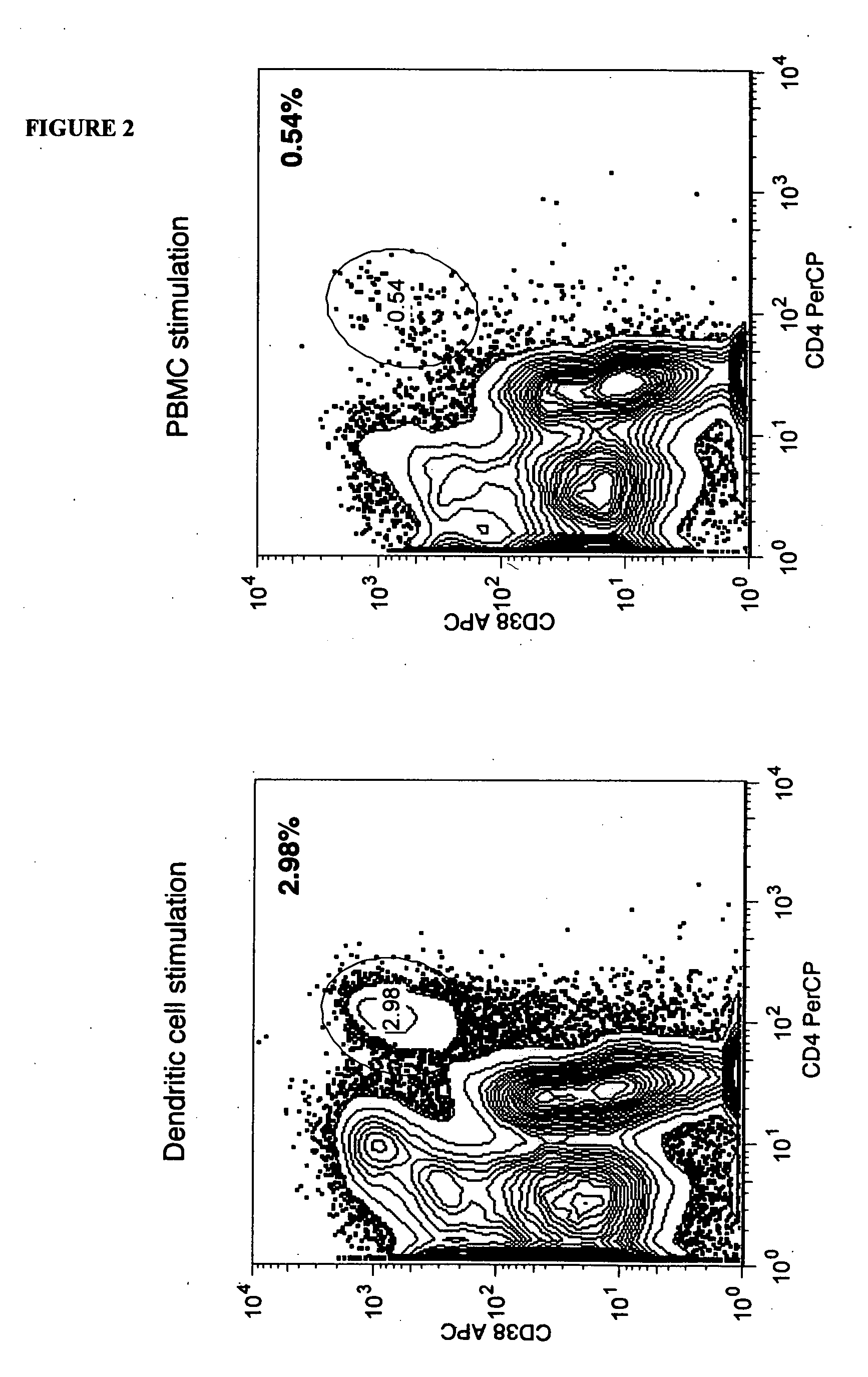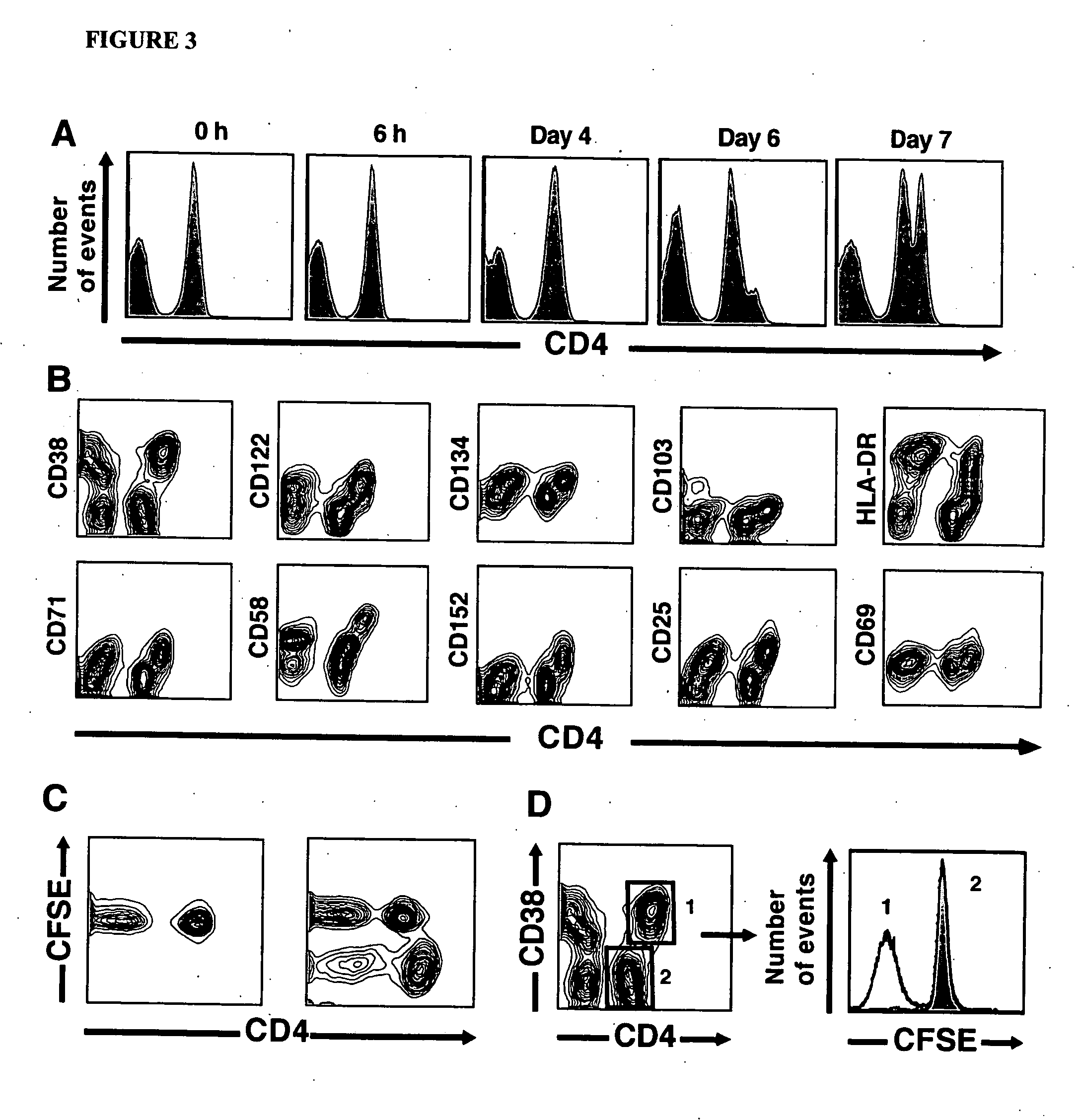Functional assessment, specific enrichment and specific depletion of alloreactive human T cells
a technology of alloreactive human t cells and functional assessment, applied in the field of alloreactive immune cells, can solve the problems of greater potential for nonspecific toxicity toward desired pbmc subsets, higher concentrations of cfse may be toxic to t cells, and inability to safely apply such an approach in humans, so as to reduce the rejection of solid organ grafts, reduce the risk of infection, and limit viral reactivation.
- Summary
- Abstract
- Description
- Claims
- Application Information
AI Technical Summary
Benefits of technology
Problems solved by technology
Method used
Image
Examples
example 1
[0086] To study the human T cell subsets responding to allogeneic stimuli, PBMC from a group of ten HLA-disparate individuals were pooled to provide a stimulus for responder T cells. To prevent proliferation from pooled stimulator PBMC, these cells were irradiated prior to incubation with responder cells. Responder PBMC were isolated from healthy donors and co-cultured with pooled allogeneic stimulator cells for varying periods. Following stimulation, the T cells were washed and brefeldin A, an inhibitor of intracellular transport, was added to enable accumulation of effector cytokines in the cytoplasm. Responder T cells were then examined for the simultaneous expression of phenotypic markers associated with T cell maturation or activation, and the production of effector cytokines by CFC.
[0087] Stimulator cells were labeled with PKH-2 to determine how long irradiated allogeneic stimulators persisted in mixed lymphocyte reactions. PKH-2+ stimulator cells were present in declining nu...
example 2
[0092] Stimulation may be accomplished using dendritic cells or PBMC. Initial experiments were performed as noted above using stimulation with peripheral blood mononuclear cells (PBMC) derived from individuals or pools of allogeneic donors. In some cases it may prove advantageous to stimulate responder cells using alternate subsets of cells derived from non HLA-identical individuals. Monocyte-derived dendritic cells (DC) are known to be robust stimulators of allogeneic T cell responses. For this reason, the ability of allogeneic DC to serve as stimulators in the activation phase of the allodepletion process was evaluated.
[0093] Initially, monocytes were derived from PBMC using adherence to tissue culture plastic as a means of enriching the monocyte fraction. This results in significant enrichment of CD14+ monocytes from which DC may be derived. However, alternate approaches to isolate monocytes exist and are also envisioned as embodiments of this approach. Such methods of enrichmen...
example 3
[0098] Specific depletion of alloreactive or CMV-specific CD4+ T cells. To deplete antigen-specific CD4+ T cells, 107 responder PBMC were stimulated with CMV lysates, an equal number of PBMC from an allogeneic pool, or autologous PBMC. After seven days, the responder cells were harvested, washed and then labeled with anti-CD4PerCP and CD38APC MAb (BD Biosciences). The cells were then sorted using a FACSAria flow cytometer (BD Biosciences), excluding CD4hiCD38+ cells. Prior to sort-based allodepletion, cells were resuspended in PBS containing 0.1% AB serum and disodium edetate (5 mM final concentration)(Sigma). Following sorting, cells were washed twice in PBS prior to further functional assessment. For spectratyping studies, both CD4hiCD38+ and CD4intCD38− populations were selectively purified. For assessment of residual antigen-specific T cell function, the residual population of cells were rested for 16 h and then re-stimulated (as described above) with either thawed allogeneic or...
PUM
| Property | Measurement | Unit |
|---|---|---|
| volume | aaaaa | aaaaa |
| total volume | aaaaa | aaaaa |
| volumes | aaaaa | aaaaa |
Abstract
Description
Claims
Application Information
 Login to View More
Login to View More - R&D
- Intellectual Property
- Life Sciences
- Materials
- Tech Scout
- Unparalleled Data Quality
- Higher Quality Content
- 60% Fewer Hallucinations
Browse by: Latest US Patents, China's latest patents, Technical Efficacy Thesaurus, Application Domain, Technology Topic, Popular Technical Reports.
© 2025 PatSnap. All rights reserved.Legal|Privacy policy|Modern Slavery Act Transparency Statement|Sitemap|About US| Contact US: help@patsnap.com



